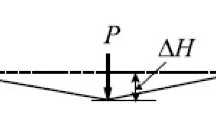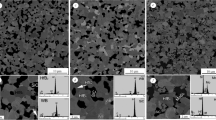The hot pressing process was employed to produce dense ultrahigh-temperature ZrB2–15 vol.% SiC–5 vol.% WC ceramics. Refractory (Zr, W)C and WB phases emerged in hot pressing at 2050°C and 30 MPa with a holding time of 15 min. The hot pressing process was peculiar in that a (Zr, W)B2 solid solution formed at the zirconium boride grain boundaries. Annealing in vacuum at 1600°C decreased the amount of oxygen in the ceramics from 0.3 to 0.1 wt.% through interaction of B2O3, SiO2, and ZrO2 with tungsten carbide. The ZrB2–15 vol.% SiC–5 vol.% WC ceramics had 505 ± 60 MPa strength at room temperature and 802 ± 94 MPa strength at 1800°C. The high strength at 1800°C was reached through transcrystalline fracture of zirconium boride grains. High-temperature oxidation resulted in scale consisting of three layers: borosilicate glass as the upper layer, zirconium oxide with other oxide phases (WO3 and SiO2) as the middle layer, and the base material depleted of boron and silicon as the lower layer. At an oxidation temperature of 1500°C and a holding time of 50 h, the scale was 85 μm thick, including a SiO2–B2O3 layer 64 μm thick and a layer of ZrO2 + SiO2 + MexOy and base material depleted of boron and silicon. At an oxidation temperature of 1600°C and a holding time of 2 h, the scale was 84 μm thick, including a SiO2–B2O3 layer 10 μm thick and a layer of ZrO2 + SiO2 + MexOy and base material depleted of boron and silicon. The dense scale developed on the material allowed 70% of its initial strength to be retained after oxidation at 1500°C with a holding time of 50 h and 50% strength after oxidation at 1600°C for 2 h, which was higher than for the base ZrB2–15 vol.% SiC–5 vol.% ceramics.





Similar content being viewed by others
References
R. Borrelli, A. Riccio, D. Tescione, R. Gardi, and G. Marino, “Thermo-structural behavior of an UHTC made nose cap of a reentry vehicle,” Acta Astronaut., 65, 442–456 (2009), https://doi.org/10.1016/j.actaastro.2009.02.016.
G.J.K. Harrington and G.E. Hilmas, “Thermal conductivity of ZrB2 and HfB2,” Ultra-High Temp. Ceram.: Mater. Extrem. Environ. Appl., 9, 197–235 (2014), https://doi.org/10.1002/9781118700853.ch9.
D.L. McClane, W.G. Fahrenholtz, and G.E. Hilmas, “Thermal properties of (Zr, TM)B2 solid solutions with TM = Ta, Mo, Re, V, and Cr,” J. Am. Ceram. Soc., 98, 637–644 (2015), https://doi.org/10.1111/jace.13341.
O.N. Grigoriev, I.P. Neshpor, T.V. Mosina, V.B. Vinokurov, A.V. Koroteev, O.V. Buriachek, D.V. Vedel, A.N. Stepanchuk, and L. Silvestroni, “Behavior of ultrahigh-temperature ZrB2-based ceramics in oxidation,” Powder Metall. Met. Ceram., 56, No. 9–10, 573–580 (2018), https://doi.org/10.1007/s11106-018-9930-z.
L. Silvestroni, G. Meriggi, and D. Sciti, “Oxidation behavior of ZrB2 composites doped with various transition metal silicides,” Corros. Sci., 83, 281–291 (2014), https://doi.org/10.1016/j.corsci.2014.02.026.
L. Silvestroni, S. Failla, I. Neshpor, and O. Grigoriev, “Method to improve the oxidation resistance of ZrB2-based ceramics for reusable space systems,” J. Eur. Ceram. Soc., 38, 2467–2476 (2018), https://doi.org/10.1016/j.jeurceramsoc.2018.01.025.
W. Li, Y. Zhang, X. Zhang, C. Hong, and W. Han, “Thermal shock behavior of ZrB2–SiC ultra-high temperature ceramics with addition of zirconia,” J. Alloys Compd., 478, 386–391 (2019), https://doi.org/10.1016/j.jallcom.2008.11.045.
P.V. Mazur, O.N. Grigoriev, D.V. Vedel, and L.M. Melakh, “Properties of ZrB2–SiC–CrB2 ceramics produced by vacuum sintering,” Elektron. Mikrosk. Mitsn. Mater., No. 25, 43–54 (2019), DOI: http://www.materials.kiev.ua/publications/ EMMM/2019/11.pdf.
Y.H. Seong and D.K. Kim, “Oxidation behavior of ZrB2–xSiC composites at 1500°C under different oxygen partial pressures,” Ceram. Int., 40, 15303–15311 (2014), https://doi.org/10.1016/j.ceramint.2014.07.036.
W.B. Han, P. Hu, X.H. Zhang, J.C. Han, and S.H. Meng, “High-temperature oxidation at 1900°C of ZrB2–xSiC ultrahigh-temperature ceramic composites,” J. Am. Ceram. Soc., 91, 3328–3334 (2008), https://doi.org/10.1111/j.1551-2916.2008.02660.x.
P. Hu and Z. Wang, “Flexural strength and fracture behavior of ZrB2–SiC ultra-high temperature ceramic composites at 1800°C,” J. Eur. Ceram. Soc., 30, 1021–1026 (2010), https://doi.org/10.1016/j.jeurceramsoc.2009.09.029.
L. Silvestroni, H.J. Kleebe, W.G. Fahrenholtz, and J. Watts, “Super-strong materials for temperatures exceeding 2000°C,” Sci. Rep., 7, 1–8 (2017), https://doi.org/10.1038/srep40730.
F. Monteverde and L. Silvestroni, “Combined effects of WC and SiC on densification and thermo-mechanical stability of ZrB2 ceramics,” Mater. Des., 109, 396–407 (2016), https://doi.org/10.1016/j.matdes.2016.06.114.
D. Sciti, M. Brach, and A. Bellosi, “Long-term oxidation behavior and mechanical strength degradation of a pressurelessly sintered ZrB2–MoSi2 ceramic,” Scr. Mater., 53, 1297–1302 (2005), https://doi.org/10.1016/j.scriptamat.2005.07.026.
J. Zou, G.J. Zhang, S.K. Sun, H.T. Liu, Y.M. Kan, J.X. Liu, and C.M. Xu, “ZrO2 removing reactions of groups IV–VI transition metal carbides in ZrB2 based composites,” J. Eur. Ceram. Soc., 31, 421–427 (2011), https://doi.org/10.1016/j.jeurceramsoc.2010.10.011.
H. Bin Ma, G.J. Zhang, H.L. Liu, J.X. Liu, Y. Lu, and F.F. Xu, “Effect of WC or ZrC addition on thermal residual stresses in ZrB2–SiC ceramics,” Mater. Des., 110, 340–345 (2016), https://doi.org/10.1016/j.matdes.2016.08.009.
J. Zou, G.J. Zhang, C.F. Hu, T. Nishimura, Y. Sakka, J. Vleugels, and O. Van Der Biest, “Strong ZrB2–SiC–WC ceramics at 1600°C,” J. Am. Ceram. Soc., 95, 874–878 (2012), https://doi.org/10.1111/j.1551-2916.2011.05062.x.
V. Korobtsov, V. Balashev, and K. Bazarsad, “B2O3 decomposition on the Si (100) surface,” Phys. Low-Dimens. Struct., 2, 34–41 (2006).
B. Post, F.W. Glaser, and D. Moskowitz, “Transition metal diborides,” Acta Metall., 2, 20–25 (1954), https://doi.org/10.1016/0001-6160(54)90090-5.
I.L. Shabalin, Ultra-High Temperature Materials I. Carbon (Graphene/Graphite) and Refractory Metals, Springer Dordrecht Heidelberg, New York, London (2014), https://doi.org/10.1007/978-94-007-7587-9.
Yu.B. Kuz’ma, T.F. Fedorov, and E.A. Shvets, “Phase equilibria in the system Zr–W–C,” Powder Metall. Met. Ceram., 4, No. 2, 106–109 (1965), https://doi.org/10.1007/BF00777011.
L. Silvestroni, S. Failla, V. Vinokurov, I. Neshpor, and O. Grigoriev, “Core–shell structure: An effective feature for strengthening ZrB2 ceramics,” Scr. Mater., 160, 1–4 (2019), https://doi.org/10.1016/j.scriptamat.2018.09.024.
L. Silvestroni, N. Gilli, A. Migliori, D. Sciti, J. Watts, G.E. Hilmas, and W.G. Fahrenholtz, “A simple route to fabricate strong boride hierarchical composites for use at ultra-high temperature,” Compos. Part B Eng., 183, 1–22 (2020), https://doi.org/10.1016/j.compositesb.2019.107618.
S.C. Zhang, G.E. Hilmas, and W.G. Fahrenholtz, “Oxidation of zirconium diboride with tungsten carbide additions,” J. Am. Ceram. Soc., 94, 1198–1205 (2011), https://doi.org/10.1111/j.1551-2916.2010.04216.x.
J. Zou, V. Rubio, and J. Binner, “Thermoablative resistance of ZrB2–SiC–WC ceramics at 2400°C,” Acta Mater., 133, 293–302 (2017), https://doi.org/10.1016/j.actamat.2017.05.033.
L. Silvestroni, D. Sciti, F. Monteverde, K. Stricker, and H.J. Kleebe, “Microstructure evolution of a Wdoped ZrB2 ceramic upon high-temperature oxidation,” J. Am. Ceram. Soc., 100, No. 4, 1760–1772 (2017), https://doi.org/10.1111/jace.14738.
A.L. Chamberlain, W.G. Fahrenholtz, G.E. Hilmas, and D.T. Ellerby, “High-strength zirconium diboridebased ceramics,” J. Am. Ceram. Soc., 87, 1170–1172 (2004), https://doi.org/10.1111/j.1551-2916.2004.01170.x.
G.R. Kowach, “Growth of single crystals of Zr2W2O8,” J. Cryst. Growth, 212, 167–172 (2000), https://doi.org/10.1016/j.jcrysgro.2011.12.081.
A.L. Chamberlain, W.G. Fahrenholtz, and G.E. Hilmas, “Pressureless sintering of zirconium diboride,” J. Am. Ceram. Soc., 89, 450–456 (2006), https://doi.org/10.1111/j.1551-2916.2005.00739.x.
Author information
Authors and Affiliations
Corresponding author
Additional information
Translated from Poroshkova Metallurgiya, Vol. 60, Nos. 1–2 (537), pp. 76–86, 2021.
Rights and permissions
About this article
Cite this article
Vedel, D., Grigoriev, O., Mazur, P. et al. Structure, Strength, and Oxidation Resistance of Ultrahigh-Temperature ZrB2–SiC–WC Ceramics. Powder Metall Met Ceram 60, 60–68 (2021). https://doi.org/10.1007/s11106-021-00215-3
Received:
Published:
Issue Date:
DOI: https://doi.org/10.1007/s11106-021-00215-3




